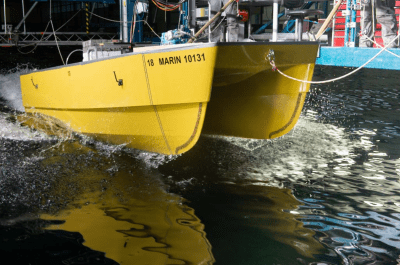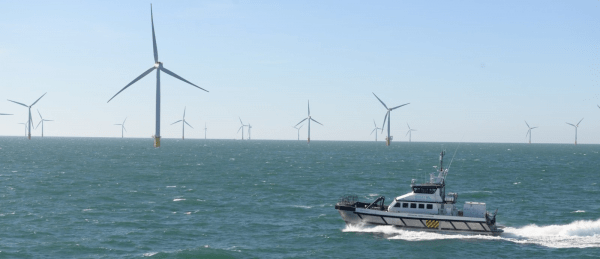SPOWTT project provides fresh insight into ship motions, improving the wellbeing of technicians.
The recently completed ‘Improving the Safety and Productivity of Offshore Wind Technician Transit’ (SPOWTT) project focused on improving the health and safety of technicians by developing models for a decision-support tool, assisting the shore operator in the ‘go/no go’ decision. Both ship motion and human response modelling were performed. MARIN was tasked with investigating the motion behaviour of Crew Transfer Vessels.
To tackle ship motions, we used numerical simulations, model tests and full-scale performance data from an elaborate measurement campaign carried out on different CTVs over multiple years. Numerical predictions were performed using MARIN’s PANSHIP code, which is suitable for fast and advanced hull forms, and includes the modelling of propellers/waterjets, rudders, lifting surfaces, interceptors and trim flaps.
Project partner BMO Offshore deployed its Vessel Motion Monitoring System to gather motion data on 14 vessels from five operators across five wind fields. In total 2,071 days were monitored, resulting in around 2,500 transit trips. Wave conditions were obtained from the Copernicus 027 hindcast model[1].
To be able to better isolate and address different uncertainties, seakeeping model tests were performed in our Seakeeping and Manoeuvring Basin. MARIN’s generic CTV model design was used, which represents a 25 m catamaran of 90 tonnes displacement.
Comparisons between the measurements and numerical predictions showed significant discrepancies. The main contributors to the uncertainty are the vessel properties (used as input for the simulations) and the limitations of the hindcast model used for wave conditions.
The results from the model tests were in agreement with the numerically predicted values. Results from tests in regular waves showed a very good match, while those from irregular waves highlighted the sensitivity to the directional distribution of wave components, confirming a hypothesised uncertainty contribution in the full-scale comparison.
Future work will focus on the following:
Improving the input of numerical simulations to derive better predictions of vessel motions, accelerations and ultimately, seasickness.
Improving the fidelity of the environmental conditions during in-service testing. In-situ wave data should include a high level of detail such as frequency content and directional spreading, and is ideally obtained by performing wave measurements on board.
Other project findings highlight the potential of using advice systems that could assist the captain. These can increase comfort levels and thereby improve the operability of CTVs and wellbeing of technicians. Additionally, a preliminary investigation into the use of hydrofoils on the MARIN model indicate beneficial effects on the motions. Further investigations are recommended.
[1] Copernicus Marine Environment Monitoring Service, http://marine.copernicus.eu/



